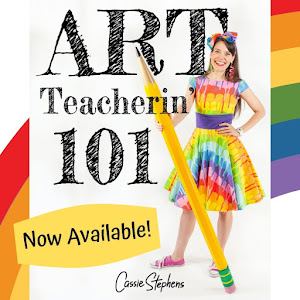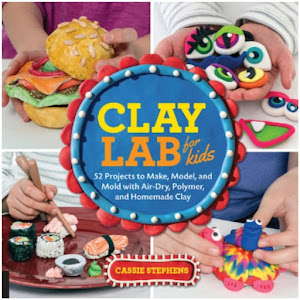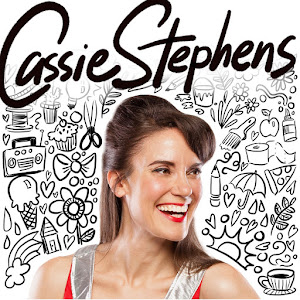Despite the dust-bowl-esque appearance of the art room, I love teaching clay as much as the kids do working with it. Seeing what creations they come up with is always so much fun. Howevers, with the wee ones in kindergarten-town, I like to start with the basics of hand building construction (slab, coil, sphere) in a pretty structured way.
Which leads me to this here Clay Butterfly project. If you're new to teaching clay or you simply need a quick project that teaches the basics of clay construction in a fool-proof-ish kind of way then this big bad butterfly is the thing for you. Here's what you'll need:
- Low Fire Clay (I use cone 06)
- No kiln to fire the clay? No worries. Try this out with air dry clay or Sculptey, available at craft stores.
- Skewer
- Toothbrush and cup of water
- Texture for the butterfly. We use a lot of lace, doilies and placemats in my art room.
- A butterfly template, optional
- Crayons
- Watercolor paint
When I introduce clay, I have the kids gather around a table and do a demo from start to finish. Then I run through the entire thing again, this time having them repeat the directions after me. I thought I'd share with ya'll the start-to-finish routine...but don't worry, I won't make you repeat it back.
On auto-repeat, I tell the kids: You can make ANYTHING outta clay as long as you can make a Slab, a Coil and Sphere. With those three things, anything is possible. First, I have 'em make a slab.
1. Begin by squishing the clay as hard as you can between your two hands. Then thump it down onto your textured surface (this thumping-down business is always a hit, no matter what the age) and begin pounding the daylights outta that clay. Now, you're gonna have to remind the kids that the goal is not to punch they clay too much, it's not your brother after all. The end result should be a clay that is a consistent cookie thickness.
Sometimes you can pound and pound that clay and it just won't get wide enough. So I tell the kids to pound their clay at a diagonal to help the clay stretch and become the desired width.
The end result should have the texture of your pounding and be consistently cookie thick.
2. Peal that clay off of your texture like a Fruit Roll-Up. I have to tell the kids that otherwise they'll simply dig at it with their fingernails. If you show them how to pull the clay and the texture away from each other, it's much easier. Also, isn't that texture rad? Clay is so receptive to texture that I'm always showing kids ways to incorporate that into their clay piece. Lace is my personal fave.
3. Once the clay has been pealed off of the texture, have the kids trace a butterfly template (not shown, duh). Or, if you are a Template Hater, don't. I use templates for this activity as the focus is on working with clay. If I can remove the frustration of drawing and redrawing a butterfly onto clay, them Ima gonna do it. When the kids cut into the clay, show them how to properly use that skewer stick. It should stand up vertically, like a solider. If the kids hold it like a pencil, they either just saw through the clay (leaving behind a chewed up looking edge) or don't cut all the way through.
4. Once they've gotten that slab butterfly body made, I teach 'em how to make a coil. For them, that's old hat. That's like the very first thing all kids make outta clay: a snake! Using my extra clay, I roll out a coil that is as long as the center of the butterfly. If I make it too long, I cut it to size with my skewer.
5. Now, I don't use a scoring tool, I use a toothbrush. I do use the terminology "slip and score" and explain to them that it's the glue that binds it all together. Without it, your clay project is sure to fall apart and you'll be so super sad. Don't let it happen to you.
6. Stick that coil to the slab. In my demos, we chatted for a hot minute about the three parts of the butterflies body and used our pinching fingers to create them.
7. Using spheres, we created eyes for our butterfly. Again, we toothbrushes because we didn't want our eyes to fall off. It totes sucks when that happens. Eyelashes (because all butterflies have 'em, right?) and mouthes were added along with anything else the kinderkiddos might imagine.
8. When they brought their finished pieces to me, I wrote their names on the back and stuck two holes in the head for antennae and a hole in each wing for hanging. You might not want to do this in front of the children, especially if you fail to tell 'em what you're doing as stabbing their clay project proves to be a traumatic experience for some...not that I've ever done it or anything. Ahem.
Now, bisque or first firing these guys was cake because I could just stack 'em up on my kiln shelves. But I knew that glaze firing would involve many rounds of loading and unloading the kiln because of the flat and wide nature of the pieces (in case I'm not speaking your language: you cannot stack glazed pieces in the kiln as they'll stick together once fired). If you recall from earlier in this here post I mentioned that EVERYONE in the UNIVERSE was making something out of clay so glaze firing all of these really would have slowed my firing to a snail's pace. Therefore, I knew I had to find a glazing alternative.
I gave the kids watercolor paint and we had a chat about crayon resist. It helped that we'd dabbled in this in a previous lesson so the kids kinda got the concept. I told 'em that bright colors worked the best and that coloring super hard was the key to making this work. I likened it to putting a raincoat on the butterfly so that when it got wet with the paint, the paint would roll right off the rain coat. We also chatted about the symmetrical nature of a butterfly's design which inspired some kids. For others, they either weren't interested in that or their texture pattern made it too difficult to create a symmetrical design.
Once the crayon coloring business was through, the kids were free to paint. I asked them to pick one color (my friend above chose not to but the end result is lovely) and really like really had to stress painting away the white spots. The key is to have a moppy wet brush and to paint slow enough for the paint to sink into the crevices. Once complete, I slapped some ModPodge on 'em and my fourth grade morning helpers added the hanger. I added a dot of hot glue inside each opening at the top, inserted the antennae and, viola! Kindergarten Clay Butterfly!
What are some of your fave kindergarten clay projects? I'd love to hear, ya'll!












































































